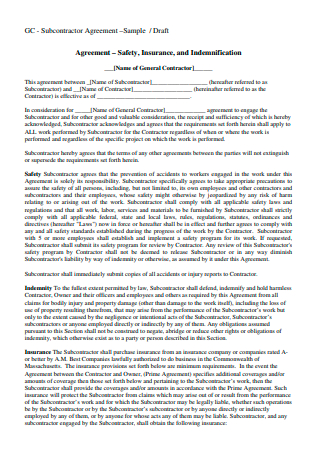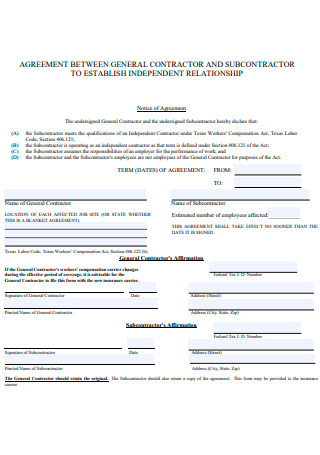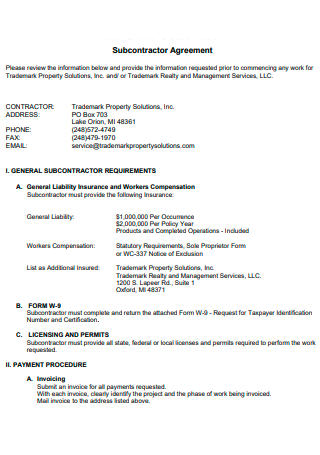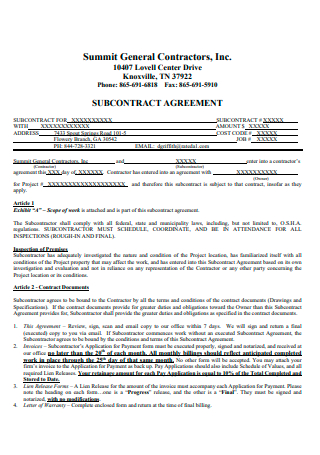3+ Sample General Subcontractor Agreement
FREE General Subcontractor Agreement s to Download
3+ Sample General Subcontractor Agreement
What Is a General Subcontractor Agreement?
What Is the Importance of a General Subcontractor Agreement?
When to Use a General Subcontractor Agreement?
Who Needs a General Subcontractor Agreement?
What Are the Things to Consider in a General Subcontractor Agreement?
What Are the Benefits of a General Subcontractor Agreement?
Why Is the General Subcontractor Agreement Necessary?
Elements of a General Subcontractor Agreement
How to Write a General Subcontractor Agreement
FAQs
Are subcontractors classed as employees?
Can I modify your subcontractor agreement template?
Who is the first part of a subcontractor agreement?
What Is a General Subcontractor Agreement?
A subcontractor is a term that refers to an individual or corporation that performs work for another contractor as part of a bigger project. Contractor subcontractor agreements are particularly prevalent in the construction industry, where specialized skills are contracted to finish large-scale construction projects. For instance, a contract project manager may employ a bricklaying company to construct a new school in a newly developed suburban neighborhood. A general subcontractor agreement is then a formal document between a contractor and a subcontractor that details the terms and conditions of the work to be performed. Bear in mind that a subcontractor is only liable to the contractor who hired them and is only there to fulfill their contractual obligations.
Other templates are available on our website, and you can use them whenever you need them. They are as follows: business proposal, subcontractor agreement, non-disclosure agreement, roofing subcontractor agreement, contractor agreement, independent contractor agreement, subcontractor confidentiality, bid proposal, non-compete agreement, disclosure agreement, and other similar templates are available. This post will not only provide you with templates but will also provide you with important information that you need to know in order to complete your template.
What Is the Importance of a General Subcontractor Agreement?
When a contractor engages a contractor who then contracts another subcontractor to complete work as part of a huge project, the situation can get quite complicated. The risk in this situation is that details will be misread, payments will be missing, and work will not be finished on schedule. All of these scenarios have the potential to severely derail a project. A general subcontractor agreement ensures that activities are tightly controlled, targeted, and consistent across all parties involved in the project.
When to Use a General Subcontractor Agreement?
According to the size and scope of your company’s operations and projects, you may find yourself using subcontractor agreements on a regular basis. A general subcontractor agreement will be required each time you need to outsource services in order to complete a project. As a contractor or project manager, you most likely have a clear sense of where you stand in terms of being able to complete a project. Even before taking on a new customer, you may want to go out to your network to get subcontractors to ensure that the project will be completed on time. You’ll also need a general subcontractor agreement if your current subcontractors are no longer able to perform their duties and you need to find new ones to take over for them. Finally, if extra time is required to complete the task, you may need to employ general subcontractor agreements to prolong the duration of the contracts.
Who Needs a General Subcontractor Agreement?
The subcontractor template simplifies the process of creating legal documents. The paper is straightforward to complete because all of the relevant clauses are already included in the text. The contractor can outline the terms of the agreement to make it clear who is responsible for what work and what the scope of the work is. This will help to avoid confusion later on. It is critical that the contract contains precise wording in order to ensure that all parties who have agreed to the conditions are legally protected. The following parties stand to gain from the use of a subcontractor agreement form:
- Those who own commercial property
- Construction contractors
- Contractors; corporations
- Entrepreneurs and sole proprietorships
- Homeowners
- Independent contractors hiring
- Individuals seeking to hire
- Subcontractors
- Lawyers
- Limited liability corporations
- Small business proprietors
What Are the Things to Consider in a General Subcontractor Agreement?
A contractor should consider several factors before getting into a subcontractor agreement with another. To begin, the contractor must ascertain whether the client is prepared to authorize subcontracted work. When a contractor enters into an agreement with a client to finish a project, the contractor and client enter into a contractual relationship. The contract is referred to as a Master Agreement. Within that master agreement, the customer will indicate whether or not the contractor is permitted to subcontract out any portion of the project. If this is not specified in the agreement, it should be presumed that the client does not wish for the job to be completed by anybody other than the original contractor. If the Master Agreement prohibits the contractor from recruiting subcontractors, the contractor is legally obligated to abide by its conditions. The Master Agreement must contain specific wording defining the contractors’ and subcontractors’ responsibilities and obligations. The contracting party must be held harmless for any errors or damage caused by a subcontractor’s work. If this legal wording is not included in the document, the contractor may be liable for damages or errors. Corporations, proprietors of small businesses
What Are the Benefits of a General Subcontractor Agreement?
A contractor should consider several factors before getting into a general subcontractor agreement with another. To begin, the contractor must ascertain whether the client is prepared to authorize subcontracted work. When a contractor enters into an agreement with a client to finish a project, the contractor and client enter into a contractual relationship. The contract is referred to as a Master Agreement. Within that master agreement, the customer will indicate whether or not the contractor is permitted to subcontract out any portion of the project. If this is not specified in the agreement, it should be presumed that the client does not wish for the job to be completed by anybody other than the original contractor. If the Master Agreement prohibits the contractor from recruiting subcontractors, the contractor is legally obligated to abide by its conditions. The Master Agreement must contain specific wording defining the contractors’ and subcontractors’ responsibilities and obligations. The contracting party must be held harmless for any errors or damage caused by a subcontractor’s work. If this legal wording is not included in the document, the contractor may be liable for damages or errors. Corporations, proprietors of small businesses.
Why Is the General Subcontractor Agreement Necessary?
Every industry has its own set of norms. So, regardless of the type of project you are working on, you will need to put some fundamental principles in place to effectively manage your projects. The most important thing to remember about contracts is that they must be in writing because verbal agreements are not always regarded as legally binding or meaningful. To do so, you must document the set of instructions that will regulate the interaction between you and the subcontractors who will be employed by you. It is guaranteed by the agreement that there will always be rules to obey. Because you will be working under written terms, it will be difficult for anyone involved in the arrangement to violate the terms and circumstances of the business agreement.
Elements of a General Subcontractor Agreement
You must draft a subcontract agreement that will govern your business relationship with the subcontractor you select. You can plan the agreement using the template provided below. The following are three best practices for drafting a successful subcontractor agreement.
How to Write a General Subcontractor Agreement
When an individual or business, referred to as an ‘independent contractor,’ is unable to undertake the obligations essential to finish a project, a subcontractor is recruited. This is a regular occurrence in construction when specialized tasks must be done before the entire project can be completed. The contract is solely between the independent contractor and the subcontractor.
Step 1: Save This Subcontractor Contract To Your Computer From This Page
On this page, you can download the paperwork as a PDF or word processing file. Each button associated with the preview (PDF, Word, and ODT) opens the agreement in the associated file type. Open, view, and then download this documentation in the format of your choice.
Step 2: Both Parties to This Contract Must Be Identified
The document’s opening article will be titled “I. The Parties.” Here, we shall identify the date of this agreement, as well as the two parties involved. Begin by providing the contract’s calendar date. Present the contract date for this paperwork in the first two blank places of the first paragraph.
Step 3: The Client’s And Subcontractor’s Required Services Must Be Clearly Documented
The Client referred to in this document is the entity that hired the Contractor previously. We must identify this third party in the second article, “II. The Client,” in order to enrich the terminology included therein. To do so, we must enter the Client’s complete name (as it appears in the agreement with the Contractor) in the first blank box. The next three blank fields will be used to display the Client’s official mailing address.
Step 4: Outline Some Fundamental Job Specifications
Naturally, work must take place at a specific location. The following part, “V. Location,” will require us to describe the location of the Subcontractor’s physical presence when working for the Contractor. If this is a permanent location, check the first check box in this column and type in the street address, city, and state in the first blank field. Mark the second checkbox if the location must be chosen in the future (by the Contractor).
Step 5: Additional Information Regarding The Subcontractor
The tenth article of this agreement (“X. Subcontracting”) will discuss the Contractor’s willingness to permit the Subcontractor to hire others to execute the job detailed here. If this is the case, check the first box under “Right To Subcontract.” If the Contractor believes this is not suitable, he or she should tick the item under “No Right To Subcontract.”
Step 6: Both Parties Must Work Together To Complete This Agreement
This template will become a legally enforceable contract only after both the Contractor and Subcontractor have read the finished result, reviewed all attached documents, and signed their names at the bottom. Once both of these parties are prepared to execute this assignment, the Contractor will have access to the first section at the end of this page. He or she must next sign the blank line labeled “Contractor’s Signature” and indicate the “Date” on which the signature was submitted. Additionally, he or she must print their names on the line below and the entire name of their company on the “Company Name” line.
A general subcontractor agreement is between a contractor and a subcontractor for the purpose of assisting the contractor in completing a project or service. Typically, the independent contractor will have a contract for services with a client, most frequently in the construction industry, and will choose to employ a subcontractor to complete some or all of the services. The agreement should detail the subcontractor’s obligations, liabilities, and responsibilities, as well as any other requirements.
FAQs
Are subcontractors classed as employees?
Employees are paid and have access to paid vacation and pension plans. A subcontractor is a company hired to do a specific job.
Can I modify your subcontractor agreement template?
Yes, we understand that agreements may need to be changed based on project scope. That’s why our template comes in Word and PDF file formats so you can easily edit it.
Who is the first part of a subcontractor agreement?
The Contractor is the first to be defined. This is the entity that signed the client contract and plans to hire the Subcontractor.
The general subcontractor agreement is a lengthy document that details the duties and responsibilities of a hired subcontractor. Additionally, it defines the requirements that a hiring contractor must follow while engaging in a subcontractor arrangement. The parties and their contact information are the bare minima of information contained in this vital document. Without the assistance of a subcontractor agreement template, it is possible to overlook an essential clause that protects one or more parties to the agreement. With the legal safeguards provided by the document, taking the time to carefully fill one out is simply good business sense.




